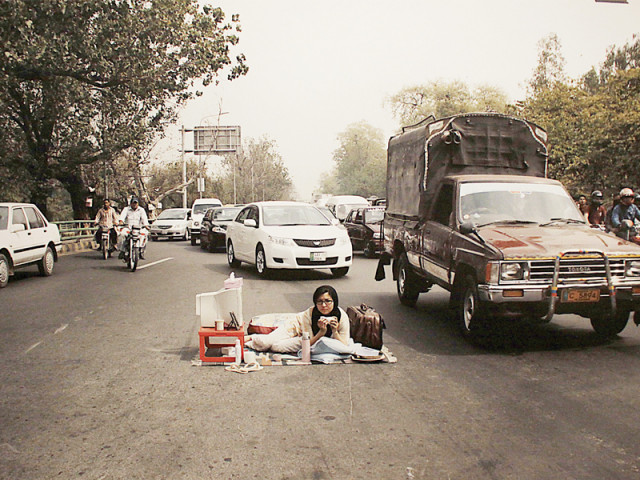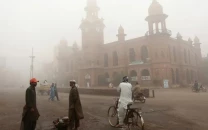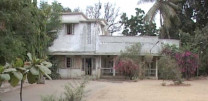Thesis display: ‘My work is all about experiencing life’
Beaconhouse National University art students showcase their creativity.

Students whose works went on display graduated from the fine arts department, department of jewellery design, textile design department and the department of visual communication.
As many as 40 graduates of the Mariam Dawood School of Visual Arts and Design at the Beaconhouse National University displayed their theses here at the university’s Tarogil campus on Sunday.
Students whose works went on display graduated from the fine arts department, department of jewellery design, textile design department and the department of visual communication.
Fine Arts
Umber Majeed, 23, a fine arts graduate who was born and brought up in the US, has explored the feeling of displacement while trying to relate to her South Asian roots in her thesis.
“It was the sense of displacement which I wanted to understand,” she says.
Majeed has recreated Frido Kahlo’s The Two Fridas by replacing Kahlo with herself in a video installation that gives the illusion of movement.
“That is perhaps what Frida also wanted to explore in her painting…I can relate to it,” she adds.
Majeed says the question: ‘Who am I?’ is what inspired her to go on with the project. She says she wants to pursue a master’s but before that she says she would like to travel and work for a while.
Hailing from a small village near Sibbi in Balochistan, 26-year-old Ghulam Mohammad has explored the relationship between language and identity in his thesis.
Mohammad recalls his reluctance to speak his mother tongue when he came to Lahore for his studies four-years-ago. He says he felt ‘intimidated’ by Urdu at first.
“I realised that English had taken up that role – not because of the language itself but because of the perceptions people had created,” he says.
Mohammad spent two months creating a piece weaving an 11x19 feet fabric using paper strips he says he made from various books on Urdu language.
He says he views language as an integral part of one’s identity, which is also visible in his thesis. Urdu words sprawling across a wall, making sense only when read from left to right instead of the other way around.
“As an artist, my work is to pose questions and I hope to take forward the question of a fragile identity.” Mohammad says.
Zoya Siddiqui, 22, a fine arts graduate who majored in digital arts attempted to explore and define space in her project.
“I wanted to convert video into 3D to make it feel more real for the viewer,” says Siddiqui, who projected videos on glass creating video sculptures.
She says it took her almost two months to set up the installation on display with research work which consumed most of her time last school-year.
Ranging from power failures to a lack of resources, Siddiqui says the challenges she had to face were huge. She says social problems like being a young female did not help either.
“I am daring, not worried about the consequences as such,” says 26-year-old Kubra Khademi, who moved to Lahore from Kabul to pursue her studies at BNU. “I wasn’t satisfied there. I could not find what I was looking for.”
Khademi’s work includes pictures of her own performances. “I wanted to create my space using my body, even when it involved taking a risk,” she says.
There are pictures of her sitting in the middle of a road, apparently oblivious to traffic. Khademi says the work represents her effort to secure her space.
“Life is all about experiencing – that is how I describe my work,” she says.
Visual Communication Design
Tamimur Rahman Popal, 22, one of the four Afghan students graduating this year from the SVAD, has used his personal experiences to weave a narrative of stereotyping, questioning the concept of identity.
“I wanted to experience another world and I got the chance,” says Popal, who had been studying at the Kabul University when he got a full scholarship at BNU.
Recalling his journey from Kabul to Peshawar, he says the security officials gave him a tough time because of his appearance. “They would stop us…and ask who we were and why we were there,” he says.
Popal says he has tried to recreate the experience in his work through snapshots of himself showing how he has transformed over the years.
From facing difficulties in communicating to breaking stereotypes, he says he has loved his experience in Lahore.
“Objects give us identity,” he adds, saying his clothes will determine the perceptions about him. Popal hopes to explore other parts of the world for future studies.
Another visual communication design graduate, Sajjad Rafiq, has reflected upon Saadat Hassan Manto’s ideas about society and its flaws. Rafiq has focused on sectarian violence which he claims is “one of the many things that worried Manto.”
“Similar behaviours are repeated throughout our history,” he says, “my work raises the question whether or not we remain where we started 60-years-ago.”
25-year-old Rafiq hopes to work as a communication designer.
After several trips to the Lahore Zoo, Samreen Farooq devised a method to make the visit interesting as well as informative. Graduating in VCD, Farooq has designed a zoo based on the current set up of the City zoo but with additional features including a mascot – the 10-year-old lion, Zoodo.
“During my visits I realised how dull and boring the trips were,” she says.
Farooq says she felt that the children were not provided enough information about the animals they saw at the zoo.
Her thesis includes plans for various activities including scavenger hunting and giving out customised handouts based on the animal kingdom.
The zoo ticket in her design is steeply priced at Rs150 to Rs200. She believes this will help generate funds to sustain the design of the zoo.
Farooq is sure her idea is implementable but has not pitched it to the zoo authorities yet.
Published in The Express Tribune, May 27th, 2013.



















COMMENTS
Comments are moderated and generally will be posted if they are on-topic and not abusive.
For more information, please see our Comments FAQ